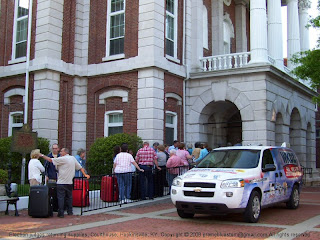Working the election

Dennis and I were poll workers in Kentucky's primary election on Tuesday.
As judges, one of our responsibilities was to provide the voters with the correct ballots and to tell them how to record the ballots on the machines. It was a primary election, so the Republicans had a different ballot than the Democrats.
One of our machines the E-Slate, has been used for several elections now. It is designed to make voting easier for disabled people. A wheelchair can roll right up to the screen and controls. The buttons and dials are large, and there are earphones. The words on the screen are in a large font.
The other machine, the E-Scan, is a new machine that we used for the first time. Many of the voters were apprehensive when told they'd be using a new machine. However, many remarked afterward that voting had been quick and easy.
We gave each E-Scan voter a paper ballot and explained how to mark it. The voter took the ballot to a privacy booth, marked it, and signed his name on a stub at the bottom of the ballot. Next, the voter brought the ballot to the E-Scan machine. He tore off the stub with his signature and put it into a slot in the side of the E-Scan. Then he fed the ballot into the scanner.
The E-Scan refused to accept a couple of ballots. In both cases, there were marks in too many boxes. One man had made a mistake and partially blackened an extra box. The other fellow told us that he did not realize he could only vote for one in each race. He had voted for several.
We couldn't look at their ballots to figure out the problem -- that would have been illegal. Rather, we made suggestions, based on the error message. The spoiled ballots were put into the slot in the side of the machine, and the voters received fresh ballots to try again.
Our precinct's voting place is a country church basement. The church members are having supper and a revival meeting every night this week. There were lots of leftovers in the refrigerators, and they urged us to help ourselves. We did try their banana pudding and Strawberry Delight. The Strawberry Delight was wonderful -- I must get that recipe! (This sounds like it.)
 After we locked the doors at 6 p.m., we closed the machines and printed the tallies. Then the machines were taken down and secured. That completed the day for the other election workers, but the judges (Dennis and I) had to take the election returns to the courthouse.
After we locked the doors at 6 p.m., we closed the machines and printed the tallies. Then the machines were taken down and secured. That completed the day for the other election workers, but the judges (Dennis and I) had to take the election returns to the courthouse.At the courthouse, we waited in line to have our suitcase checked. The girls from the county clerk office checked each ease for the control unit for the E-Slate, the voter register, the clerk's and sheriff's records, leftover ballots, and the envelopes that contained the vote tallies. It was a rather nervous moment when they opened our suitcase, and we were relieved when we had checked out OK.
It was a long day (5:15 a.m. when we left the house and 7:45 p.m. when we got home.) We got to see a lot of our neighbors though, and we helped them vote, so it was a day well-spent.
5 comments:
My father used to volunteer at the polls. I admire people who take their civic duties seriously enough to do that thankless job.
Hi, Mark. We had a full crew of poll workers in every precinct for the first time in my poll worker experience. That may be because the poll worker wage has recently been raised by $25. It is now $125 ($25 for the class and $100 for Election Day).
Democracy should never come cheap!
The last time my father worked at the polls was at least 10 years ago. At that time I think they got a token payment, something like $25 or $30. I think it's more now.
The pay for poll workers varies from state to state and even from precinct to precinct within some states. Here's an interesting report on poll workers that cites pay as high as $9.50 per hour in Alaska and over $300 for the day for some New York jurisdictions -- and pay as low as nothing at all in some precincts in Vermont that are entirely staffed by volunteers.
Post a Comment